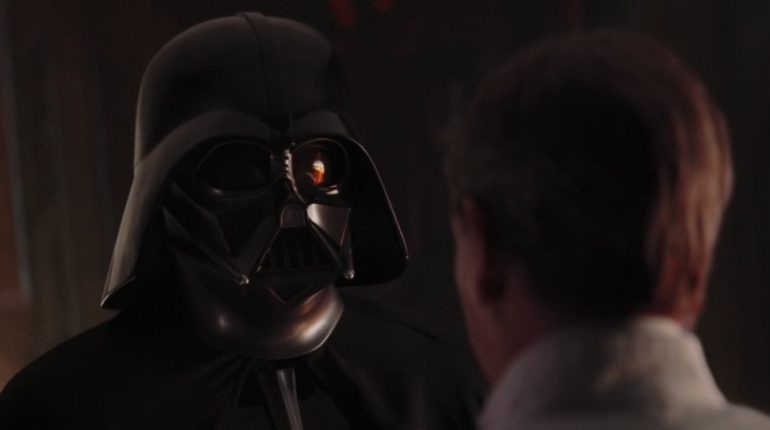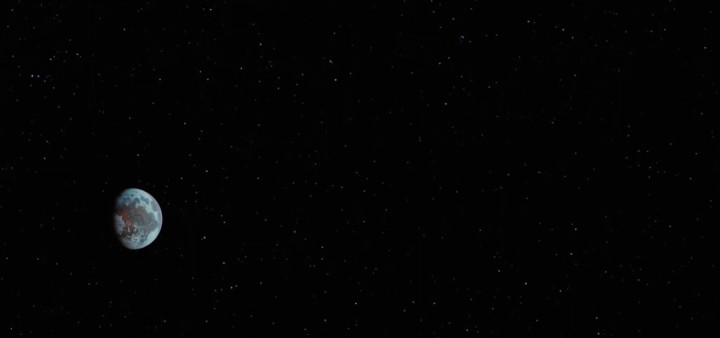
Rogue One: A Star Wars Story opens with a single blast of horns and percussion in the exact place you’d expect to see the classic Star Wars crawl. It’s a jarring start. Perhaps this is intentional, a single-note attempt at grabbing the audience’s attention and letting them know this won’t be your typical Star Wars movie. I don’t want to throw composer Michael Giacchino under the bus here, because he’s a considerable talent, and following in the footsteps of a master like John Williams has to be a teeth-gnashingly daunting prospect. But something about this decision just feels off to me.
It’s a feeling that persists through Rogue One‘s first hour and a half or so, as we suffer a relentless barrage of “wait, what?” moments. It’s not until the film’s final act that we see the emergence of anything that remotely resembles a compelling story.
But even in the mess Rogue One makes of its first two acts, the most horrible scene in the entire film is the one in which we’re shown Darth Vader for the first time. Here, we see a villain that — aside from the iconic costume and James Earl Jones’ voice — is barely recognizable as the Darth Vader of the original Star Wars trilogy. In fact, this version of Anakin seems like he comes straight out of a piece of fanfiction written by a twelve-year-old boy.
First off, he lives in a lava castle in Mordor. As insane as that sounds, I’m not making it up.
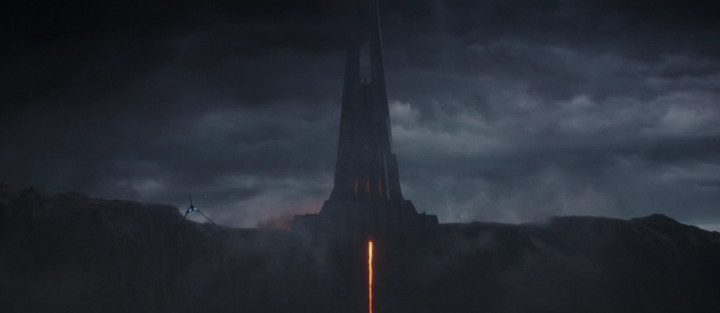
Now, before you start drooling like a dying tauntaun while you point out the inaccuracy in what I just said, yes, I’m fully aware that this isn’t actually the Mordor of The Lord of the Rings; it’s Mustafar, the same place we saw Anakin lose a considerable amount of his body parts at the end of Revenge of the Sith. But the resemblance to that unholiest of all the places of Middle-Earth is downright uncanny.
This doesn’t feel at all consistent with the Star Wars universe as a whole; it’s some weird anomaly out of a completely different piece of fiction. It’s almost as if some little kid was playing with a Darth Vader action figure and, for lack of a more appropriate backdrop, paired it with his Castle Grayskull playset.
Now, that drooling tauntaun I mentioned earlier — wait, didn’t we cut that thing open and shove a half-dead Skywalker into it? — is about to mention how I’m missing the point. This was a visual reference to a piece of concept art Ralph McQuarrie had done while working on The Empire Strikes Back. While McQuarrie is an incredibly talented guy who’s responsible for a good deal of the classic Star Wars look (and probably the best Atari game box art of all time), there’s a reason this concept didn’t make it into the film; it simply wasn’t the right choice.
And, let’s be clear that official concept art of a thing doesn’t make that thing canon. Keep in mind that, in McQuarrie’s concept art, this is what Chewbacca looked like:
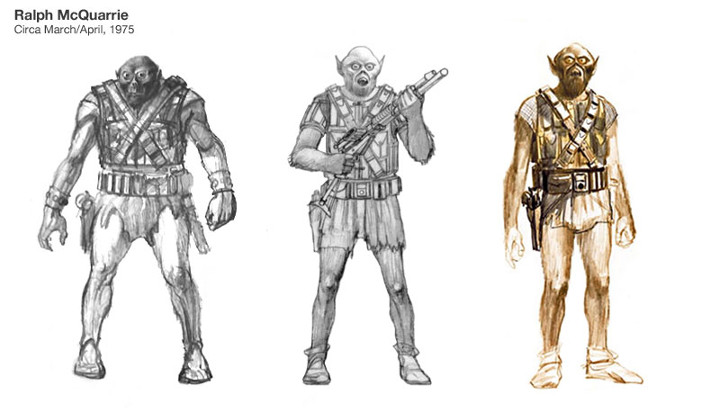
Just like this terrifying version of Chewbacca, the lava castle was abandoned for the better ideas that would eventually become The Empire Strikes Back (which is, by the way, the best Star Wars movie ever made). Unfortunately, the Rogue One team didn’t understand why an idea this absurd would be cut from a movie like Empire, so they carelessly forced it into theirs.
After the cringe-inducing establishing shot, Rogue One doesn’t try to salvage this mess of a scene; things only get worse from here.
When we’re introduced to Vader himself, he’s not yet wearing the classic helmet; he’s getting all steamy in a Bacta Tank.
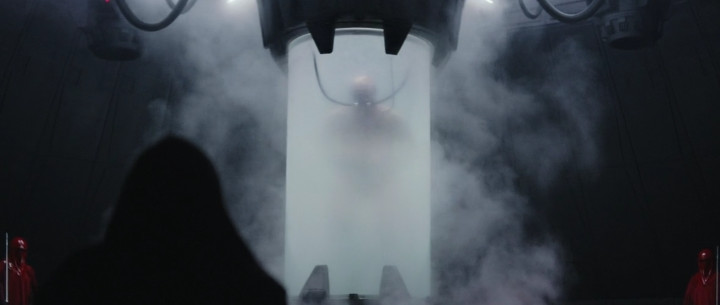
This is kind of hard to see through all that fog, but this version of Vader looks more like Bane as portrayed in Christopher Nolan’s The Dark Knight Rises than an older version of Hayden Christensen who’d had all his limbs removed.
In the original trilogy, we’re told that Vader is “more machine now than man” by the wise Obi-Wan Kenobi (the same Obi-Wan Kenobi, in fact, that sliced off all those limbs back on Mustafar. Good times indeed.) At the point on the Star Wars timeline that Rogue One occupies, Anakin is a guy on life support. Yes, the Bacta Tank is basically a healing tube (as Luke’s Bacta Tank was in Empire), but we’re not seeing a sickly old man here; we’re seeing a beast made of pure muscle. To underscore the effect, everyone in this room is clearly terrified.
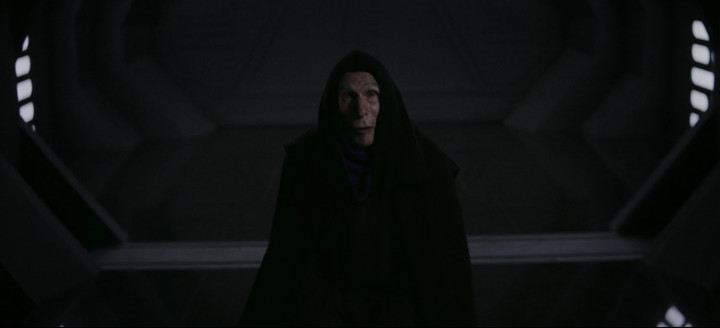
Krennic especially. You can practically hear the pee dribbling down this guy’s leg.
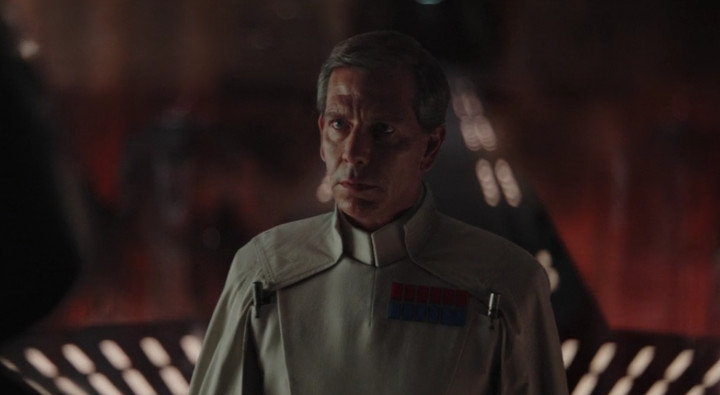
I have to assume the genesis of this idea comes from the scene in Empire where we see Vader in a rare moment of weakness as his helmet is being placed over his head by a machine. We’re shown the scarred, patchy head of a man who’s clearly seen some hard times before the mask is clamped over it.
This is a pivotal scene in Empire, because it humanizes Vader. We are faced with the uncomfortable reality that underneath that mask, the ultimate badass is a fragile human being like anyone else. And this is especially important because one of the core themes of Return of the Jedi is the redemption of the human being beneath the mask.
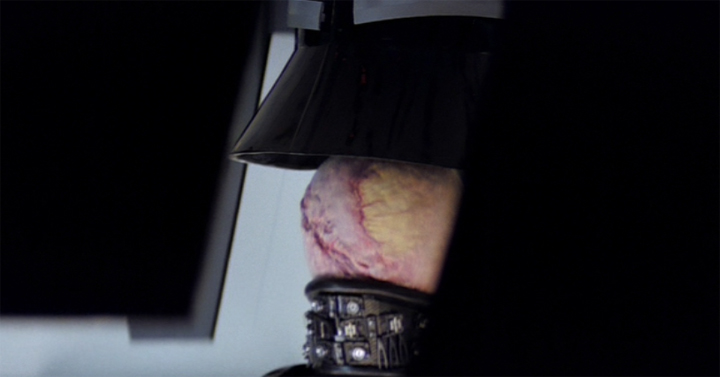
What is Anakin’s dying request? That his mask be removed. This is symbolic of his turning away from the evil the mask represents, even though it was keeping him alive for decades. It’s a poignant scene, and the fact that it was set up way back in Empire shows how masterfully Vader’s character arc was handled throughout the entire original trilogy.
So why does Rogue One show us the Bacta Tank? It’s clearly not meant to humanize Vader in this film; that would be meaningless, since Vader only exists in this movie as a ruthless killing machine. If it’s a callback to Empire, it was so poorly handled that it suggests the makers of Rogue One didn’t really understand the significance of the scene they were referencing.
For an example of a masterful reference to the original trilogy, let’s take a look at how The Force Awakens handles Vader’s helmet.
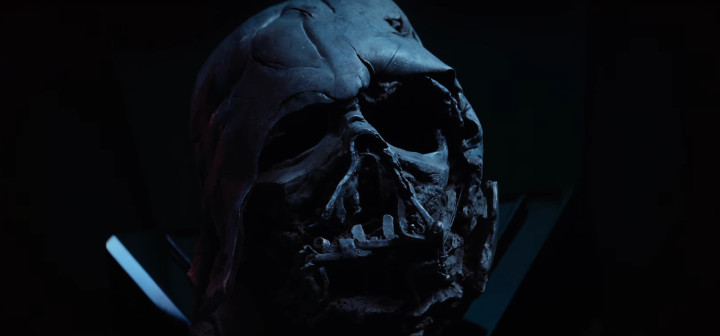
Kylo Ren keeps Vader’s melted mask as a sort of relic. He talks to it. Prays to it. Asks it for advice. Yet, what Ren doesn’t understand — and what longtime Star Wars aficionados should understand — is that the mask represents the evil that consumed Anakin, an evil that was shaken off in a final moment of redemption. It’s very significant that Ren possesses the mask (representing the evil) and that the mask is empty (representing the idea that Anakin is no longer a prisoner to that evil). This is just one of hundreds of details that show that the creative minds behind The Force Awakens had a very deep understanding of how to truly evoke the exact emotions that a good Star Wars film should.
In the most ridiculous moment of Rogue One‘s Mustafar scene, we witness Darth Vader making a horrible pun. Yes, we have a man who’s completely consumed by an overwhelmingly powerful evil, and he ends his conversation with a bad pun. Listen carefully, and you’ll hear the hesitation in Jones’ voice as he delivers this line. It makes me sad to think of poor old James Earl Jones — the possessor of one of the most listenable human voices that ever was — being forced to recite this schlock. It sounds like a thing you might hear in a Saturday morning cartoon from the early 1990s.
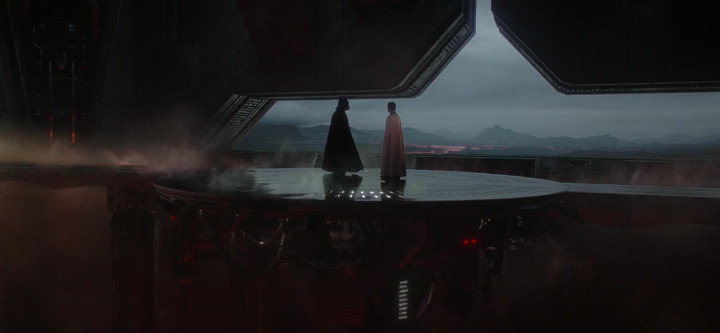
So what’s the point of this scene? It does nothing for the film, which is already poorly paced and struggling to find an identity. Is it trying to show us that Krennic is frustrated in his struggle to be appreciated for his accomplishments? If so, we’ve seen enough of his rivalry with Tarkin that we should be pretty well aware of this by now. Is it to humanize Vader, like the helmet scene from Empire? I doubt it, because Rogue One — and the Star Wars saga as a whole — benefits nothing from doing so inside this film. If it’s to simply show us Vader’s badass lifestyle, it’s kind of unnecessary, as his reappearance at the end of the film is far more successful at portraying that.
And since we’re on the topic, Vader’s appearance at the end of Rogue One is incredible. It’s completely over-the-top and gratuitous in an unashamed display of pure, unadulterated fan service. This should feel familiar to anyone who’s ever commanded Vader in the recent Star Wars Battlefront video game, or the opening scene from the less recent Star Wars: The Force Unleashed.
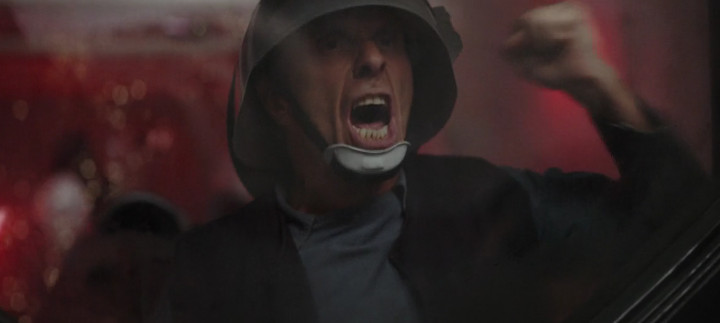
This is, by an enormous margin, the most satisfying scene in the film. But just imagine how great it would have been if this were the first time we saw Vader at all. Keeping us waiting until the very last minutes of the movie would have made it so much better.
To go back to The Force Awakens for a moment, anyone following entertainment news back in 2016 was keenly aware that Luke Skywalker was to play an important role in that film, but The Force Awakens held back that moment until its very last seconds. When we finally see Luke, with a mixed look of defeat and hope on his face, it’s an incredible moment made perfect due to the amount of restraint the filmmakers exercised in saving it for the finale.
Rogue One, however, is unwilling (or unable) to show this sort of restraint. It’s far too antsy to show us something we don’t need to see in order to simply give Darth Vader more screen time. In doing so, the payoff — that gut-wrenching, rebel-slaying, murderous rampage — is somewhat lessened. Especially when we know that Force-wielding blur of red lightsaber light is just a guy who makes awkward puns.
Rogue One is not a good movie, and it couldn’t have been wholly salvaged by removing a single scene. However, without the Mordor — errr, Mustafar — scene, it would have been a considerably better movie for sure.
